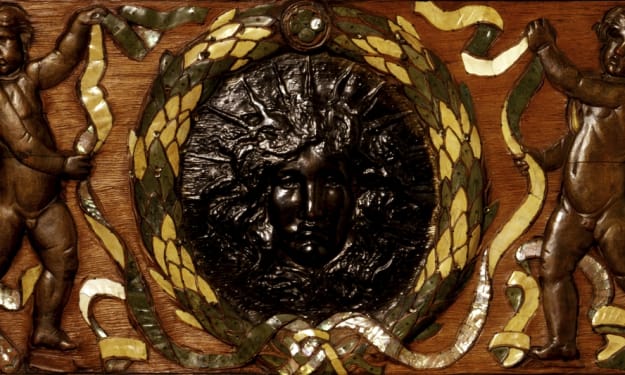Unprecedented Finds in Africa Sends Shockwaves Through Scientific Community
Settled in the midst, Africa has stunning scenes and dynamic societies on this tremendous landmass, a progression of revelations has as of late become visible that opposes all clarification, testing how we might interpret history, science, and the actual texture of our reality. From the baffling elephant deaths to the insane monster that lived with the dinosaurs, these are disclosures in Africa that no one can make sense of.

Baffling elephant deaths.
Vatsala The world's most established elephant has lived for nearly 100 years, and that implies that elephants have an amazing life span. They can, nonetheless, pass on from poaching assaults, advanced age, and ailment, so when many elephants began to kick the bucket bafflingly in the north of the Okavango Delta Locale, home to 18,000 Savannah elephants in Botswana, this news stood out as truly newsworthy. It was the end of summer, and these elephants needed to hydrate. As they drank from the water, they began to stagger, falter, and stroll around and around. In the end, as their weighty legs debilitated them and they battled to make another stride, they fell, tumbling to their chests first and afterward kicking the bucket. 44 elephants were confirmed dead in Walk 2020. By the center of June, in excess of 350 corpses had been dissipated across the remote, around 3000 square mile area; by January 2021, a bigger number of than 450 puzzling deaths had been recorded. All in all, this is a worry for preservationists. Back in 1979, there were more than 1,000,000 elephants in Africa, yet following quite a while of contracting environments and conflicts with people, the numbers have dropped to roughly 415 000 as of late under extreme worldwide tension. Botswana specialists found what was dispensing with the creatures: cyanobacteria neurotoxins. This toxin delivered by green growth and stale water was going after the sensory systems of these elephants, yet different specialists feel the proof is problematic. Assuming the cyanobacteria had killed the creatures, for what reason didn't different creatures that drank from a similar opening drop like flies? In all likelihood, we will never have a definitive response to these secretive deaths.

Bakoni ruins
Bakoni relics are round. Labyrinths of stone-assembled residences and towns connected by walled streets worked by the antiquated Bakoni individuals are tracked down on the edges of the town of Machadodorp, South Africa, too much surprise. Some call the cryptic design the lost city of South Africa.
"What happened is that antiquated Africans were accepted to be trackers and finders, and this scene proposes that the Bakoni public were agrarians yet further developed ones. This stalled labyrinth with the terraced field properties and street networks portray the design progression of these individuals and are accepted as having assisted them with dealing with their animals before the period of European settlers in Africa. Proof showed that Bocconi individuals likewise rehearsed crop pivot, and it is exceptionally agreed that these designs were worked on to improve rural yields when they were raised. Remains the subject of much discussion. Some recognized the stone walled-in areas as moderately later, dating them to be something like a few centuries old; others accept the site might have been worked on as far back as 200 000 years ago at the time of development. As the discussion proceeds, we should recall that these vestiges dissipate over a tremendous area of land, and some of them are yet to be revealed.
Insane Monster, who lived with the dinosaurs
Africa is home to various natural species; however, it isn't normal to find one that has resided there for a large number of years. In any case, one creature disrupts this guideline as well as turns what we are familiar with as biological system determination on its head. The creature is Adalatherium hui. This opossum-sized vertebrate lived during the Cretaceous time frame, which was quite a while ago. Little was known of this animal until the revelation of its fossilized skeleton in 1991. Its skeleton shows that Adalatherium is around 66 million years old and has a place with a terminated gathering of vertebrates called Gondwana Theria previously found during the 1980s, so when its hard designs were put under an inside and out study, scientists depicted the animal as having had strong rear appendages like a crocodile, strong front legs, bunny-like front teeth, and odd back teeth that look totally dissimilar to those of some other known well-edile. It likewise had an uncommon space between the bones at the highest point of its nose and more trunk vertebrae than most warm-blooded creatures we are aware of. What makes this more captivating is the creature's odd appearance. Its solid legs and large hooks on the back feet suggest that it was a strong digger; however, its front legs were less sturdy, which causes researchers to accept that this animal was a quick sprinter, although this entire situation has researchers scratching their heads. Adalatherium remains a significant piece in an extremely huge riddle on early mammalian development on the southern side of the equator, and tragically, it could take some time before we can at last find the mysteries of this subtle monster.
The skeletal coast
Africa might be a socially different and rich locale, but there is likewise a piece of it called the skeletal coast," named the "door of misery" or the land god made out of frustration." It's the northern piece of Namibia's Atlantic Sea where difficult situations and an unpleasant desert meet the coast. It gets its scary name from the great number of skeletal remains of whales, seals, and rusting wrecks that are dispersed up and down the shoreline, which makes this an exceptionally ungracious region. On its coast, the Benguela's ebb and flow causes thick sea haze during this time, which makes the route very troublesome. This coast extends for 976 miles and moves through the Kuneni Waterway and Swakop Stream in Namibia. This region likewise sees negligible precipitation of something like 0.39 inches, or 10 millimeters, each year, making it hard to get aground through the surf, however difficult it is to leave through it, essentially not until the approach of motor-controlled machines. The most effective way to escape this skeletal coast is to ride many miles of bog, with access through a searing and parched desert.
Giraffes with abnormal necks
Obviously, giraffes stand apart from other creatures due to their long necks. They need their long necks to reach foliage and contend with different creatures for food during dry spells. The necks of most giraffes are around six feet in length and weigh around 600 pounds. Despite the fact that they are so lengthy, they just have seven vertebrae in them, very much like us. Since we understand what a giraffe's neck resembles, when we see one that is unique, we simply realize there is something off-base. 36-year-old Philip Briggs from Amboseli in Kenya, on one of his visits to Chiulu Slopes, a mountain range in Makueni District in Southeastern Kenya, tracked down a completely developed giraffe with a strange neck; however, the creature appeared unbothered by its uncommon highlights. Many individuals banter about why the giraffe have a twisted neck. While certain preservationists say it could have supported a physical issue early on, others propose it could have created scoliosis, and that implies a sideways curve of the spine. Be that as it may, this Chiulu Slopes giraffe isn't the only one with a crimped neck. Amali, an 11-foot-tall, five-year-old female giraffe being moved from Ohio's Wilds to Tulsa, Oklahoma, and expected to be raised with a male at the recreation area and zoo, was found by zoo specialists to have a bended neck, a physical issue supported during the haulage. However, it appeared not to have been an issue right away; concerned zoo staff trusted its neck would develop as the calf developed, yet it turned out to be more obvious over the long run-in spite of the crisis treatment it got from equine specialists and radiologists at the zoo.
Python love
In Africa alone, there are 500 of the 3500 types of snakes on the planet. This makes Africa home to snakes, which could sound off-kilter assuming the main thought you have about snakes is that they are simple, extended, and venomous reptiles. In the event that you are this sort, you ought to be ready for a culture shock in Africa as python love spreads across this whole landmass. Northwestern Botswana houses one of the most intriguing python admirers, known as the Sand Clans. These local people have been practicing snake love for some time, and to them, these animals are the sole makers of humankind. Archeologists likewise found a cavern with a little chamber in it and a two-meter-tall stone with a snake shape around it. These archeologists found sharpened stones removed from many kilometers, accepted to have been forfeited to the snake. Likewise, dating demonstrates the training to be around 70 000 years of age. Botswana isn't the only one. Legend likewise has it that the Old Lord of Uida, Benin Republic, ran into the woods during an ancestral conflict and was safeguarded by specific pythons who kept his foes from catching him. As an approach to saying thanks to them, he developed the sanctuary for pythons in the Weda Realm. This consecrated sanctuary today is devoted to the love of 40 to 70 pythons.
Secretive metal and stone monument
It is entirely to be expected for individuals to be terrified at whatever point they see abnormal and unexplainable articles. That might have been the situation when many individuals raged at the baffling metal and stone monument that out of nowhere showed up on an indirect in Kinshasa, the capital of the majority-rule Republic of the Congo. The stone monument, which showed up in 2021, is a 12-foot, three-sided crystal that seems to be similar to other metal stone monuments that have sprung up around the world over the past few years. In any case, when the Congolese recognized this item, they were interested in realizing what was inside. This interest drove them to obliterate the stone monument, and they were simply disheartened not to see anything vile in it. One stone monument showed up in Utah in 2016 in the US, and more than five stone monuments have shown up in the Assembled Realm, including one for the Isle of Wight. These metal items have created a ruckus of late, particularly among sci-fi fans. While a portion of these stone monuments starting points have been followed, the subject of where the Kinshasa stone monument comes from remains a secret.
The strange Nubian stone tablets
Archeologists in Africa have recovered the largest assortment of texts in the strange language of the Cushites, the nearby language of Sudan. The curio was recovered from a site in Sadinga, Sudan, known as the "City of the Dead," as it contains the remains of a sanctuary devoted to the fourteenth-century BCE Egyptian sovereign Thai, the grandma of Tutankhamun, the pharaoh who managed Egypt from 1332 to 1323 BC. However little data remains about the realm of Kush, the funerary things tell a great deal. The enormous stone contains the remaining parts of no less than 80 block pyramids and 100 burial chambers. It is from these burial places that the curios were recovered by an exploration group driven by the French Public Community for Logical Exploration as a team with the French Relics Administration. What they found was odd; they tracked down burial places, lintels, and a sort of tablet stone utilized as a memorial landmark. The texts were written in Marowitic, the most seasoned compositional arrangement of the sub-Saharan locale. While a portion of these texts were totally interpreted, others are yet to be deciphered on the grounds that each text on the tablets reveals insight into something completely weird.
Strange cavern craftsmanship
In the far-off southwest corner of Egypt and southeast Libya, there lies the Gilf Kabir level, nicknamed the Incomparable Hindrance. This is 3,000 square miles of sandstone, generally the size of Puerto Rico. What makes this site famous isn't its very dry circumstances as they are presently, but that it is an extraordinary desert of landmark discoveries, particularly in 1933, when Laszlo al-mazi, a Hungarian explorer, on his undertaking toward the western side of Gilf Kabir, tracked down a watercourse, or dry valley, with acacia trees and fixes of dry grass; however, at that point he likewise staggered on something different: strange cavern craftsmanship. Laszlo was joined by Austrian essayist Richard Berman, and their discoveries showed that the workmanship contained a progression of intriguing cavern compositions, including figures of creatures and dark-painted men with red hair. However, Laszlo was not quick to find canvases like this around here; this time he made a genuinely groundbreaking track down in the valley of compositions. Hand tomahawks were found; this is characteristic of the cavern craftsmen's agrarian way of life in the green scene, and after archeologists followed the beginning of the canvases, they were found to have existed quite a while back during the African muggy period, when the desert was loaded up with water, in spite of the fact that Laszlo's hunch that the Sahara was a water-filled climate proved right. Present-day specialists propose the cavern pictures portray not swimmers but rather something more representative, such as drifting spirits or even dreams recorded by the Stone Age tenants of the district.
Half human, half canine
A ton of sensational things have been found in South Africa, yet the supposed half-human, half-canine is most certainly on the unacceptable side of this range. Somebody caught film of the 2017 appearance of canines in March. There were around three of them altogether, and two of them were genuine canines, yet for the third one, the vast majority didn't know what it was. It kind of seemed to be a dog, yet it additionally seemed to be a man down on the ground. This being was witnessed going around at numerous events, and numerous occupants detailed seeing it. The overall agreement is that it was half human, half canine. How can that be? It might likely be a canine with a minor leg issue; however, this wasn't the case when it first appeared. In 2021, a man said he had bad dreams and was frightened for a month in the wake of being followed by a half-human, half-canine beast in the Australian Outback. The one who gave his name as John was fishing in the shrub when the animal followed him from the riverbank. He snapped a picture of it and talked with a couple of individuals who recognized it as the canine man. Before this, accounts of half human, half canine dated back to 1887 in the US in Michigan.
Klerksdorp circles
Klerksdorp circles are very wonderful; they are plate-molded or round protests that diggers and rockhounds found in Ottersdal, South Africa, in 3-billion-year-old pyrophyllite stores. Initially, this article's uniqueness is that numerous pseudoscientists have concluded that these are awkward relics made by insightful creatures and not accepted to be man-made. Geologists further accept that these circles were framed because of regular cycles. They are for the most part somewhere in the range of 0.20 and 3.94 creeps in distance across, and they are either leveled or distinct circles molded after petrographic and x-beam diffraction examinations. It has been uncovered that they comprise hematite or wollastonite, some with some hematite and gothochite. A large portion of the circles are earthy in variety, while some are plain red or dim red. Some give off the impression of being more earnest than steel, having a strange resemblance to cricket balls. It's peculiar that they are made in nature, while geologists say they are framed in volcanic silt or debris, here and there, with the two furrows on them.
About the Creator
Shari Gailla
From nursing to history's embrace, I heal bodies and ignite minds. Writing whispers my tales, bridging past and present, introverted yet expressive. Words paint a vivid world, where healing and curiosity dance hand in hand. #NurseOfWords






Comments
There are no comments for this story
Be the first to respond and start the conversation.